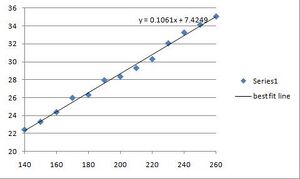Physics307L:People/Cochran/Speed of light
Summary
SJK 13:10, 14 October 2010 (EDT)

This is a good summary, and I like the inclusion of the graph. As noted below, statistical comparison to accepted value is needed in future summaries. See also primary notebook page for more comments.
The purpose of this lab was to measure the speed of light, compare it to the accepted value, and become familiar with the phenomenon of time walk. Cristhian was my lab partner for this lab. We sent a light pulse down a cardboard tube and found the time of flight of the pulse by measuring the converted voltage on the oscilloscope. We used a Tektronix TDS 1002 digital oscilloscope, a Canberra 2058 delay module, an Ortec 567 time-to-amplitude converter, a photomultiplier tube, and an LED circuit. My procedure for this lab is described in my lab notebook.
Procedure/Results
We recorded the time-generated voltage every 20 cm, beginning at 260 cm and ending at 140 cm.

To avoid incurring error by increasing the amplitude of the light pulse, we adjusted the photomultiplier tube at each increment to maintain a constant brightness and avoid time walk. We repeated this 5 times and averaged our obtained voltages, converting them to times using a factor of 10 ns/V. We plotted these times vs. distance and obtained the slope of a best fit line using Excel. . Using a Google spreadsheet, I calculated the standard error of the mean of our results and produced a value for the speed of light equal to 9.43 ± 0.87 cm/ns, compared to the accepted value of 29.98 cm/ns.SJK 13:03, 14 October 2010 (EDT)

See my comment on your notebook page regarding the mistake in the uncertainty calculation. Aside from that, what you should do here is compare the discrepancy from the accepted value (about 20 cm / ns) to the level of uncertainty (assume it's 1 cm/ns). That would mean you're off by 20 standard errors, which would be exceedingly unlikely. Thus, you can say with statistical confidence that there is some huge systematic error in your measurements --you already knew this, but we want to be rigorous in your future labs.
Conclusion
The difference between our value and the accepted speed of light points to a tremendous systematic error. Our reading of the oscilloscope could have been a little inaccurate, as it tended to fluctuate, but this is not responsible for a substantial fraction of our error. We may have calibrated the PMT incorrectly - we were not sure if the spike should be kept at the same value or at its lowest possible value for each displacement. Because of this confusion, we may have had a substantial "time walk" in our results. Cristhian and I took turns reading the oscilloscope, so there was probably variation between our data sets since we were calibrating slightly differently. I do not feel that any of these sources account for our enormous error, alone or together, except possibly time walk. If I were to do this experiment over again, I would spend more time finding out what exactly to do with the calibration spike, and have the same person calibrate every time.SJK 13:05, 14 October 2010 (EDT)

Good idea, and I'm sure you'd get good data if you were to try this again. See your notebook page for more comments about the systematic error and time walk.